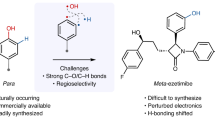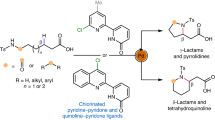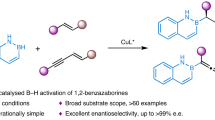Abstract
Chiral catalyst development is a key to asymmetric catalysis research. The enantioselectivity of a chiral catalyst relies on its ability to distinguish the prochiral centres or faces of substrates, which is difficult when the two groups attached to the centre or face are spatially and electronically similar. For example, dialkyl ketones are difficult to reduce enantioselectively. Here we report a protocol for the highly enantioselective hydrogenation of dialkyl ketones catalysed by a rationally designed chiral spiro iridium complex. The tridentate spiro structure and the bulky phosphino groups of the chiral ligand imparted a remarkable stability and enantioselectivity to the catalyst. The protocol is highly efficient for generating chiral aliphatic alcohols, and has potential for a wide application in pharmaceuticals and fine chemicals.

This is a preview of subscription content, access via your institution
Access options
Access Nature and 54 other Nature Portfolio journals
Get Nature+, our best-value online-access subscription
$29.99 / 30 days
cancel any time
Subscribe to this journal
Receive 12 digital issues and online access to articles
$119.00 per year
only $9.92 per issue
Buy this article
- Purchase on Springer Link
- Instant access to full article PDF
Prices may be subject to local taxes which are calculated during checkout





Similar content being viewed by others
Data availability
Data relating to the materials and methods, optimization studies, experimental procedures, DFT calculations, HPLC spectra, GC spectra and NMR spectra are available in the Supplementary Information. Crystallographic data for catalyst (R)-Cat1 is available free of charge from the CCDC under reference number 1913872. All other data are available from the authors upon reasonable request.
Change history
17 February 2021
A Correction to this paper has been published: https://doi.org/10.1038/s41929-020-00502-z
04 August 2020
A Correction to this paper has been published: https://doi.org/10.1038/s41929-020-00502-z
References
Jacobsen, E. N., Pfaltz, A. & Yamamoto, H. (eds) Comprehensive Asymmetric Catalysis Vol. I–III (Springer, 1999).
Štefane, B. & Požgan, F. Advances in catalyst systems for the asymmetric hydrogenation and transfer hydrogenation of ketones. Catal. Rev. 56, 82–174 (2014).
Gotor, V., Alfonso, I. & Garcia-Urdiales, E. (eds) Asymmetric Organic Synthesis with Enzymes (Wiley-VCH, 2008).
García-Urdiales, E., Alfonso, I. & Gotor, V. Update 1 of enantioselective enzymatic desymmetrizations in organic synthesis. Chem. Rev. 111, PR110–PR180 (2011).
Fischer, E. Influence of the configuration on the effect of the enzymes. Ber. Dtsch. Chem. Ges. 27, 2985–2993 (1894).
Reetz, M. T. Biocatalysis in organic chemistry and biotechnology: past, present, and future. J. Am. Chem. Soc. 135, 12480–12496 (2013).
Jiang, Q., Jiang, Y., Xiao, D., Cao, P. & Zhang, X. Highly enantioselective hydrogenation of simple ketones catalyzed by a Rh–PennPhos complex. Angew. Chem. Int. Ed. 37, 1100–1103 (1998).
Ohkuma, T. et al. Asymmetric hydrogenation of tert-alkyl ketones. J. Am. Chem. Soc. 127, 8288–8289 (2005).
Yamamura, T., Nakatsuka, H., Tanaka, S. & Kitamura, M. Asymmetric hydrogenation of tert-alkyl ketones: DMSO effect in unification of stereoisomeric ruthenium complexes. Angew. Chem. Int. Ed. 52, 9313–9315 (2013).
Garbe, M. et al. Manganese (i)-catalyzed enantioselective hydrogenation of ketones using a defined chiral PNP pincer ligand. Angew. Chem. Int. Ed. 56, 11237–11241 (2017).
Prelog, V. Specification of the stereospecificity of some oxido-reductases by diamond lattice sections. Pure Appl. Chem. 9, 119–130 (1964).
Jones, J. B. & Jakovac, I. J. A new cubic-space section model for predicting the specificity of horse liver alcohol dehydrogenase-catalyzed oxidoreductions. Can. J. Chem. 60, 19–28 (1982).
Keinan, E., Hafeli, E. K., Seth, K. K. & Lamed, R. Thermostable enzymes in organic synthesis. 2. Asymmetric reduction of ketones with alcohol dehydrogenase from Thermoanaerobium brockii. J. Am. Chem. Soc. 108, 162–169 (1986).
Moore, J. C., Pollard, D. J., Kosjek, B. & Devine, P. N. Advances in the enzymatic reduction of ketones. Acc. Chem. Res. 40, 1412–1419 (2007).
Nealon, C. M., Musa, M. M., Patel, J. M. & Phillips, R. S. Controlling substrate specificity and stereospecificity of alcohol dehydrogenases. ACS Catal. 5, 2100–2114 (2015).
Xie, J.-H., Liu, X.-Y., Xie, J.-B., Wang, L.-X. & Zhou, Q.-L. An additional coordination group leads to extremely efficient chiral iridium catalysts for asymmetric hydrogenation of ketones. Angew. Chem. Int. Ed. 50, 7329–7332 (2011).
Xie, J.-H. et al. Chiral iridium catalysts bearing spiro pyridine–aminophosphine ligands enable highly efficient asymmetric hydrogenation of β-aryl-β-ketoesters. Angew. Chem. Int. Ed. 51, 201–203 (2012).
Yang, X.-H., Xie, J.-H., Liu, W.-P. & Zhou, Q.-L. Catalytic asymmetric hydrogenation of δ-ketoesters: highly efficient approach to chiral 1,5-diols. Angew. Chem. Int. Ed. 52, 7833–7836 (2013).
de Vries, J. G. & Elsevier, C. J. (eds) The Handbook of Homogeneous Hydrogenation (Wiley-VCH, 2007).
Seo, C. S. G. & Morris, R. H. Catalytic homogeneous asymmetric hydrogenation: successes and opportunities. Organometallics 38, 47–65 (2019).
Dub, P. A. & Gordon, J. C. The role of the metal-bound N–H functionality in Noyori-type molecular catalysts. Nat. Rev. Chem. 2, 396–408 (2018).
Yang, X.-H., Wang, K., Zhu, S.-F., Xie, J.-H. & Zhou, Q.-L. Remote ester group leads to efficient kinetic resolution of racemic aliphatic alcohols via asymmetric hydrogenation. J. Am. Chem. Soc. 136, 17426–17429 (2014).
Arora, S., Balasubramanian, S., Bradley, W. D., William, D. & Trojer, P. Combination therapies for cancer by modulation of histone methyl modifying enzymes. International patent WO2017018975 (2017).
Anderson, B. A. et al. Application of a practical biocatalytic reduction to an enantioselective synthesis of the 5H-2,3-benzodiazepine LY300164. J. Am. Chem. Soc. 117, 12358–12359 (1995).
Nikalje, M. D., Sasikumar, M. & Muthukrishnan, M. A facile enantioselective synthesis of enantiomerically pure (R)-phenoxybenzamine hydrochloride using the hydrolytic kinetic resolution method. Tetrahedron: Asymmetry 21, 2825–2829 (2010).
Song, L., Liu, Y. & Tong, R. Cephalosporolide B serving as a versatile synthetic precursor: asymmetric biomimetic total syntheses of Cephalosporolides C, E, F, G, and (4-OMe-)G. Org. Lett. 15, 5850–5853 (2013).
Iwami, M., Shiina, T., Hirayama, H. & Shimizu, Y. Intraluminal administration of zingerol, a non-pungent analogue of zingeron, inhibits colonic motility in rats. Biomed. Res. 32, 181–185 (2011).
Goudie, A. C. et al. 4-(6-Methoxy-2-naphthyl)butan-2-one and related analogues, a novel structural class of antiinflammatory compounds. J. Med. Chem. 21, 1260–1264 (1978).
Bracher, F. & Schulte, B. Total synthesis of both enantiomers of the macrocyclic lactone citreofuran. Nat. Prod. Res. 17, 293–299 (2003).
Wijdeven, M. A., Willemsen, J. & Rutjes, F. P. J. T. The 3-hydroxypiperidine skeleton: key element in natural product synthesis. Eur. J. Org. Chem. 2010, 2831–2844 (2010).
Chang, B. et al. Ibrutinib combination therapy of cancer. International patent WO2014168975 (2014).
Babua, M. S. et al. A practical and enantiospecific synthesis of (–)-(R)-and (+)-(S)-piperidin-3-ols. Helv. Chim. Acta 97, 1507–1515 (2014).
Ju, X. et al. Development of a biocatalytic process to prepare (S)-N-Boc-3-hydroxypiperidine. Org. Process Res. Dev. 18, 827–830 (2014).
Desai, D., Chang, L. & Amin, S. Synthesis and bioassay of 4-ipomeanol analogs as potential chemopreventive agents against 4-(methylnitrosamino)-1-(3-pyridyl)-1-butanone (NNK)-induced tumorigenicity in A/J mice. Cancer Lett. 108, 263–270 (1996).
Leijondahl, K., Borén, L., Braun, R. & Bäckvall, J. E. Enantiopure 1,5-diols from dynamic kinetic asymmetric transformation: useful synthetic intermediates for the preparation of chiral heterocycles. Org. Lett. 10, 2027–2030 (2008).
Clark, R. B. et al. Synthesis and biological evaluation of 8-aminomethyltetracycline derivatives as novel antibacterial agents. J. Med. Chem. 56, 8112–8138 (2013).
Acknowledgements
We thank the National Natural Science Foundation of China (nos 21790332, 21532003 and 9195600) and the ‘111’ project (B06005) of the Ministry of Education of China for financial support. We thank H. Song of the State Key Laboratory of Elemento-Organic Chemistry for the measurement and analysis of the single-crystal structure of (R)-Cat1.
Author information
Authors and Affiliations
Contributions
Q.-L.Z. conceived this work; F.-H.Z., J.-H.X. and Q.-L.Z. designed the experiments and analysed the data; F.-H.Z., F.-J.Z. and M.-L.L. conducted the experiments; F.-H.Z. and Q.-L.Z. wrote the manuscript.
Corresponding author
Ethics declarations
Competing interests
The authors declare no competing interests.
Additional information
Publisher’s note Springer Nature remains neutral with regard to jurisdictional claims in published maps and institutional affiliations.
Supplementary information
Supplementary Information
Supplementary Methods, Figs. 1 and 2, Tables 1–4 and references.
Supplementary Data 1
The Cartesian coordinates (Å) for the transition state in DFT calculations.
Supplementary Data 2
Crystallographic data for Cat1.
Rights and permissions
About this article
Cite this article
Zhang, FH., Zhang, FJ., Li, ML. et al. Enantioselective hydrogenation of dialkyl ketones. Nat Catal 3, 621–627 (2020). https://doi.org/10.1038/s41929-020-0474-5
Received:
Accepted:
Published:
Issue Date:
DOI: https://doi.org/10.1038/s41929-020-0474-5
This article is cited by
-
Spiro-salen catalysts enable the chemical synthesis of stereoregular polyhydroxyalkanoates
Nature Catalysis (2023)
-
A 13-million turnover-number anionic Ir-catalyst for a selective industrial route to chiral nicotine
Nature Communications (2023)
-
Biomimetic asymmetric catalysis
Science China Chemistry (2023)
-
Pincer Ru with a single stereogenic identity for highly efficient asymmetric transfer hydrogenation of ketones
Science China Chemistry (2023)
-
Organocatalytic stereoselective cyanosilylation of small ketones
Nature (2022)



